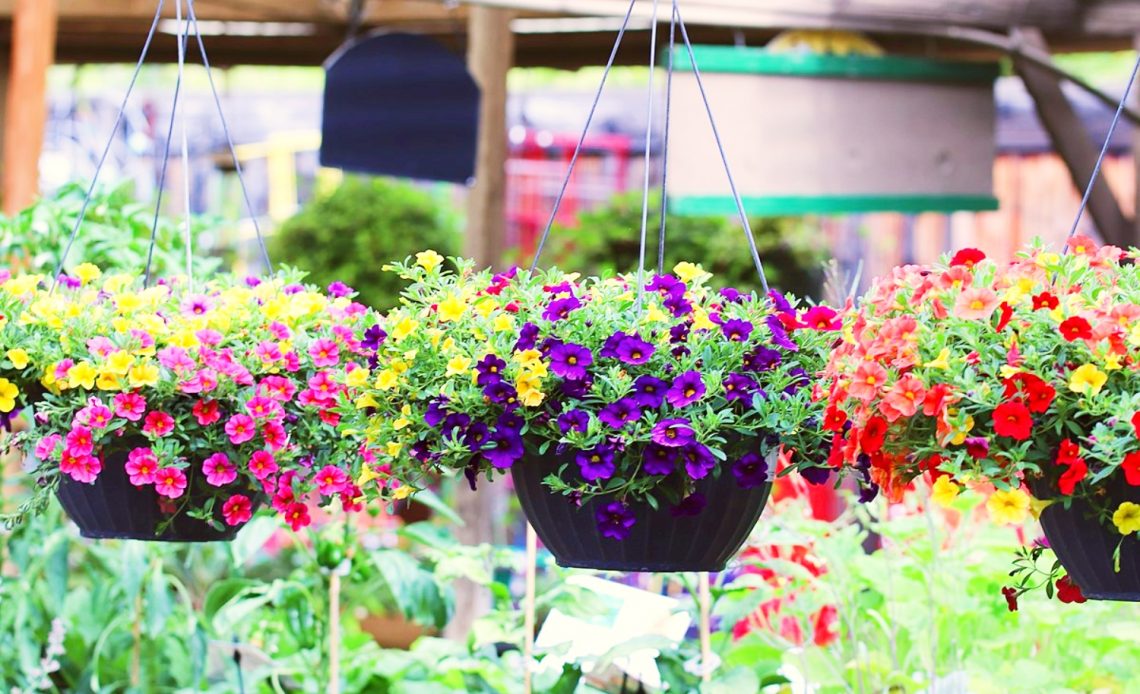

We’re here to help! Wild Yards is a completely free website that is 100% dedicated to helping you create a wildlife-friendly, sustainable yard. Read more
WildYards is reader-supported. When you buy a product through a link on our site, we may earn a comission. Every product is independently selected by our (obsessive) editors and our reviews are unbiased and objective. Read more about our mission or our privacy policy.
Hanging baskets and decorative planters are a great way to dress up your front porch or patio. They draw the eye upwards and add depth to your landscape. But if your outdoor space receives full sun, it can make choosing the right plants complicated. Most plants prefer to receive morning sun and stay in the shade, at least partially, during the afternoon. If you’re eager to fill the hanging baskets in your sunny landscape, you may be wondering, what are the best full sun hanging plants to choose?
Flowering ornamentals like trailing lantana, petunias, pansies, and black-eyed Susan vine are popular choices for outdoor full sun hanging baskets. Meanwhile, sweet potato vine and creeping Jenny add a dash of vibrant foliage to any space.
11 Best full sun hanging plants for decks, patios, porches, and more
If you’re in the middle of decorating your porch or patio, or if you want to spruce up a gazebo and display some plants from hooks in the flower beds surrounding your home’s foundation, these full sun hanging plants are just what you need!
Petunias
A popular choice for full sun hanging baskets, these delicate trumpet-shaped flowers are a lot tougher than they look. Petunias are hardy from zones 9 through 11 and are often grown as annuals. However, in warmer climates where the temperature stays above freezing in winter, petunias can be grown as perennials, making them an even more low-maintenance choice for your hanging baskets.
Petunias come in a wide variety of colors. Supertunia ‘Citrus’ petunias produce creamy yellow flowers perfect for creating a tropical feel in your backyard. But if you’re looking to create a cottage vibe, then the bright pink Supertunia Vista ‘Bubblegum’ variety might be more your speed.
Whichever cultivar you choose, petunias are easy to care for. Simply plant them in a high-quality potting soil mix, ensure the plants get good drainage, water them regularly, and they should be good to go. Your petunias will thrive when kept in full sunlight. Their classic beauty makes them a timeless choice for the sunnier spots in your landscaping.
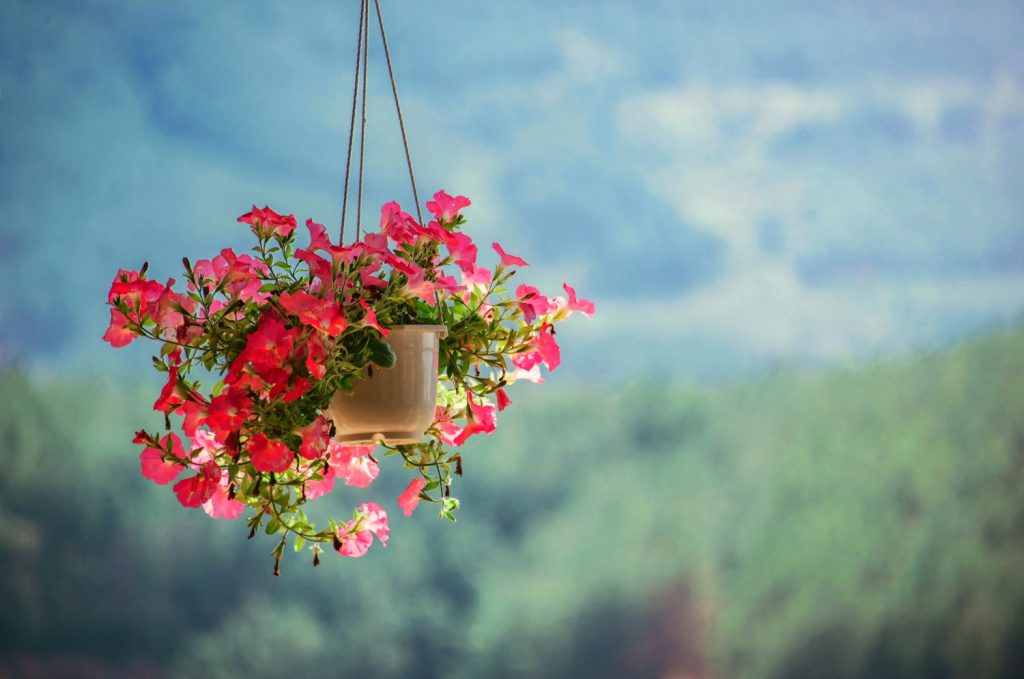
Sweet Potato Vine
Maybe you’re not looking for a floral arrangement. If greenery is your thing, look no further than the sweet potato vine. This fast-growing plant produces handsome heart-shaped leaves in shades of green, purple, and chocolate brown. Sweet potato vine adds instant appeal to your sunny outdoor space, and it practically takes care of itself.
A relative of morning glory, the sweet potato vine is a self-sufficient full sun hanging plant. Just be sure to plant your sweet potato vine in fertile, well-draining potting soil and the plant will grow well. Plants are easy to prune back to the desired size. You can even harvest the tender new growth to eat — sweet potato vine is rich in beta carotene.
Sweet potato vine is a perennial that performs best in zones 9 through 11. Plants can be grown as annuals in zone 8 if they’re protected from frosts. Traditional green sweet potato vine varieties, like ‘Margarita’, are a perfect choice for hanging up in your zen garden, but the unusual maroon ‘Blackie’ cultivar adds a dash of dignified color.
Mandevilla
Native to Central and South America, Mandevilla goes crazy in warm, humid climates, so it’s a fantastic choice for the sunny spots in your backyard. This tropical plant grows best in full sun, but can tolerate partial shade, too, and comes in a variety of vibrant colors, from the deep red Sun Parasol ‘Crimson’ to the peachy Sun Parasol ‘Apricot’.
Mandevilla is well-suited to gardens in zones 9 through 11, where it can easily be kept as a perennial. Mandevilla’s star-shaped flowers are accented by deep-green foliage that grows in a trailing habit. When planted in hanging baskets, Mandevilla cascades over the sides, creating an eye-catching floral display.
If you live in a cooler growing zone, you may still be able to grow Mandevilla. Be sure to place your hanging baskets in a place that receives 6 or more hours of sunlight per day, and move plants indoors when the temperatures dip below 40 degrees.
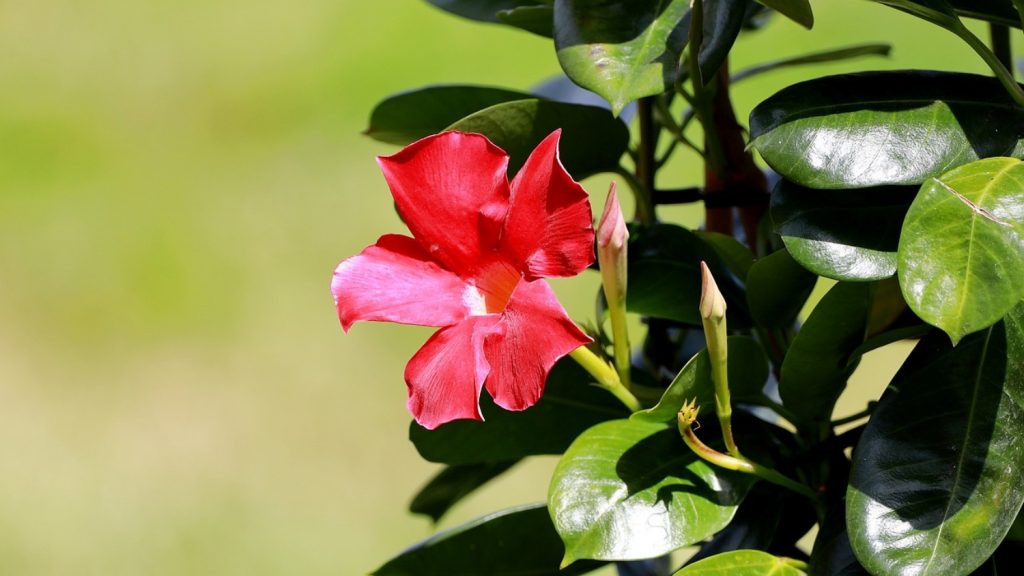
Dianthus
Fun fact: the word “dianthus” comes from the Greek “dios”, meaning divine, and “anthos”, meaning flower. These heavenly blossoms are commonly found in shades of pink, red, purple, and white, and produce cheerful, ruffled petals that are as pretty as they are tough. Dianthus is a full sun hanging plant that is hardy from zones 3 through 11, depending on the variety.
Unlike sweet potato vine and Mandevilla, which trail, dianthus has an upright growing habit. However, it doesn’t grow very tall. Most varieties only grow 6 to 18 inches tall, although some cultivars can reach heights of 3 feet.
Choose small dianthus, like the vibrant ‘Cherry Vanilla’ double-bloom variety, for your deck or patio. If you’re looking for something more understated, then ’Baths Pink’ and ‘Classic Coral’ are worth considering. Whichever dianthus tickles your fancy, be sure to keep the plants in well-draining soil and water them regularly to keep it moist, but not muddy.
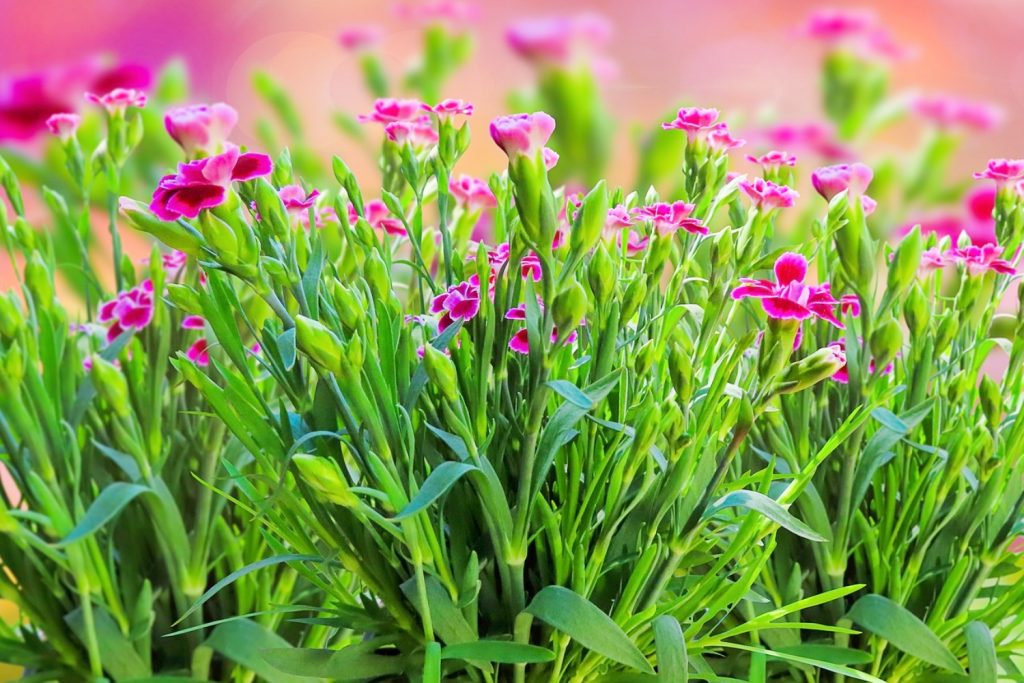
Black-Eyed Susan Vine
Featuring lovely yellow flowers with dark brown to black centers, black-eyed Susan vine is a charming plant that will give your outdoor space a happy and informal feel. This sun-loving perennial is hardy from zones 9 through 11. But it’s worth noting that black-eyed Susan vine can be grown as an annual in cooler zones. Many gardeners choose to keep their black-eyed Susan vine indoors.
Black-eyed Susan vine isn’t actually related to the wildflower black-eyed Susan. While black-eyed Susans belong to the same family as daisies and sunflowers and are native to North America, black-eyed Susan vine is a tropical full sun hanging plant native to Africa that just happens to look a lot like its namesake.
Fortunately, black-eyed Susan vine is similar to traditional black-eyed Susans in one respect — it’s easy to care for! Plant your black-eyed Susan vine in well-draining potting soil in planters that have holes drilled into the bottom. Water the plants regularly, and, above all, make sure they get plenty of sunlight. These gorgeous flowers just love the heat!
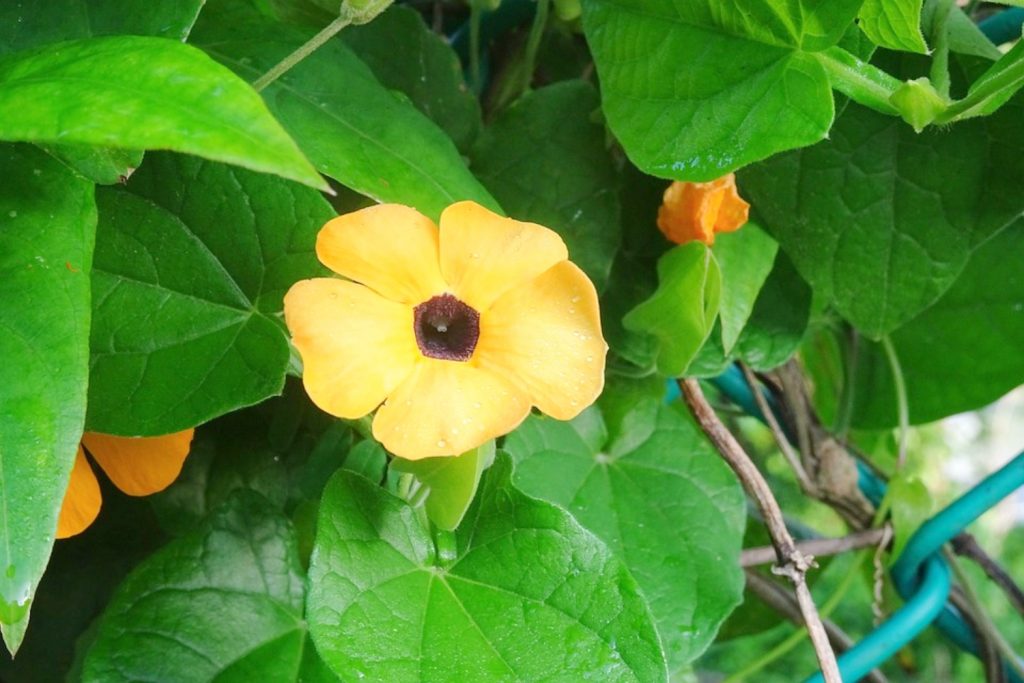
Bougainvillea
This heat-loving trailing plant is perfect for hanging baskets and planters. Bougainvillea blooms from spring to fall, when its vines are covered in paper-like petals called bracts, which come in shades of white, pink, red, and purple. This fast-growing perennial is hardy from zones 9 through 11 but can be grown as an annual in zone 8 as well.
Bougainvillea is a tropical plant, like Mandevilla, and, in fact, the two flowers look beautiful when displayed together. Although bougainvillea is a hardy plant, it is also a heavy feeder. Plants benefit from regular feedings throughout the blooming period to help them meet all of their nutritional needs.
Choose a climbing variety, like ‘Elizabeth Angus’ to plant in your hanging baskets. This violet-purple variety drapes over the edges of its container nicely, and can be trimmed back easily to maintain its shape. Although bougainvillea is drought-tolerant once established, be sure to water it regularly to maximize the plant’s blooming potential.
Pansies
Most full sun hanging plants are best suited to zones 9 through 11, where they can stay nice and warm all season long. But if you live in a cooler growing zone, which plants should you choose to grow in your hanging baskets? If you live in growing zones 4, 5, 6, 7, or 8, look to the pansy to fill your sunny garden.
Pansies love cool weather, but they also grow best when planted in full to partial sunlight. These dainty flowers produce five petals and often feature dark splotches on the lower petals, which makes each bloom look like a face. Pansies come in a wide array of colors, including orange, yellow, white, pink, red, purple, and blue. Their charming, cheery appearance makes them a great choice for spring, summer, and fall gardens.
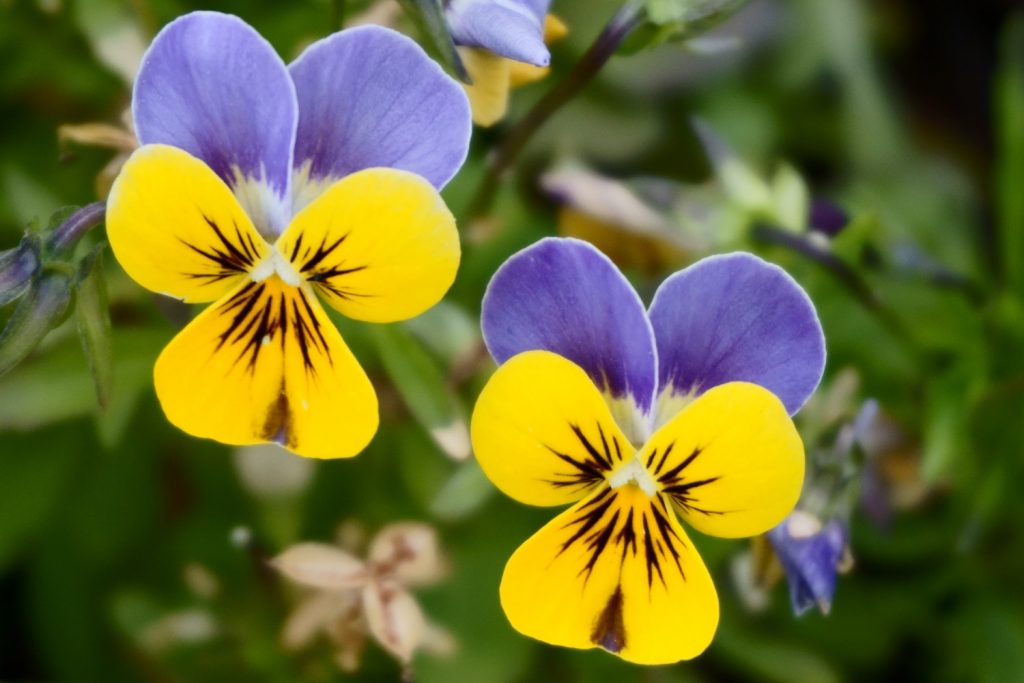
Creeping Jenny
Flowers play a critical role in decorating a landscape, but greenery is just as important. If you’re looking for a full sun hanging plant that’s more foliage than flower creeping Jenny might be just the thing. This sun-loving plant, which is also known as moneywort, produces coin-shaped leaves with a low-growing, trailing habit that makes it perfect for hanging baskets.
Creeping Jenny grows best in nutrient-dense soils that are loaded with decaying organic materials. You can use a standard potting mix for your creeping Jenny, but for best results, add a heaping handful of compost to the mix to keep the plant well-fed. Check your creeping Jenny regularly to make sure it stays moist, but be careful not to overwater the plant, either.
Your creeping Jenny will grow quickly when kept in full sun. In midsummer, plants produce small, bright yellow flowers that attract bees and other pollinating insects. Choose the gorgeous ‘Golden’ creeping Jenny for your hanging baskets, and consider planting some as a ground cover, too, to create a living mulch for your flower beds.
Alyssum
Like rosemary and lavender, alyssum is native to the Mediterranean region, so it shares many of the same growing requirements. Often grown as a ground cover, alyssum has a trailing habit that “spills” over the edges of hanging planters nicely. This perennial’s sweetly-scented clusters of yellow flowers add a splash of color to any landscape.
You can find alyssum in shades of white, pink, and purple, Some varieties, like ‘Golden Spring’ produce lovely yellow flowers, which are the perfect choice for your sunny garden. These plants grow best in nutrient-rich soil that drains well. Potting soil designed for lavender works especially well for these flowers.
Alyssum is grown as an annual in zones 3 through 11 and is a hit with pollinating insects, especially butterflies. Grow this full sun hanging plant in your butterfly garden. Alyssum is a favorite of the Monarch butterfly, and planting more of these pollinator favorites could help boost dwindling Monarch butterfly populations.
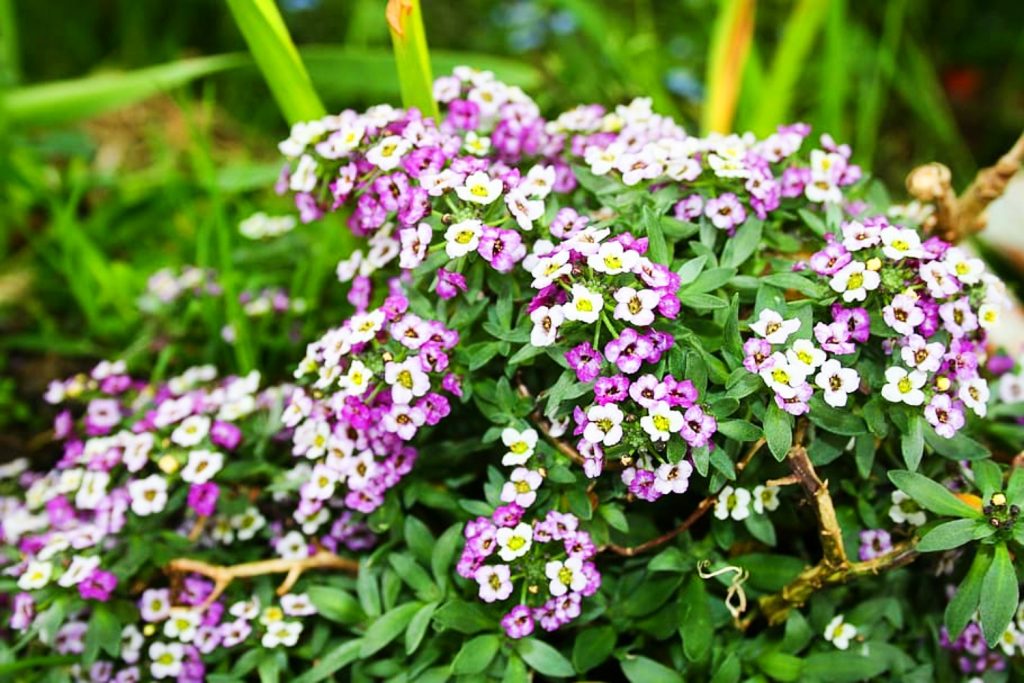
Portulaca
Also known as moss rose, portulaca is a succulent that produces small, green, lance-shaped leaves and beautiful rose-like flowers in shades of orange, yellow, pink, red, and white. This tropical plant makes a great ground cover, growing well in sandy and loamy soils alike. But this plant’s trailing nature makes it well-suited to hanging planters as well. This flowering succulent is grown as an annual in zones 2 through 11 but may be grown as a short-lived perennial in warmer climates.
Portulaca is one of over 100 species of plants in the Portulacaceae family. This group of plants is also called purslanes, and their flowers are known to attract not just bees and butterflies but also, interestingly enough, chickens! If you’ve got a flock of your own, consider planting some portulaca where your hens and roosters can enjoy it, too.
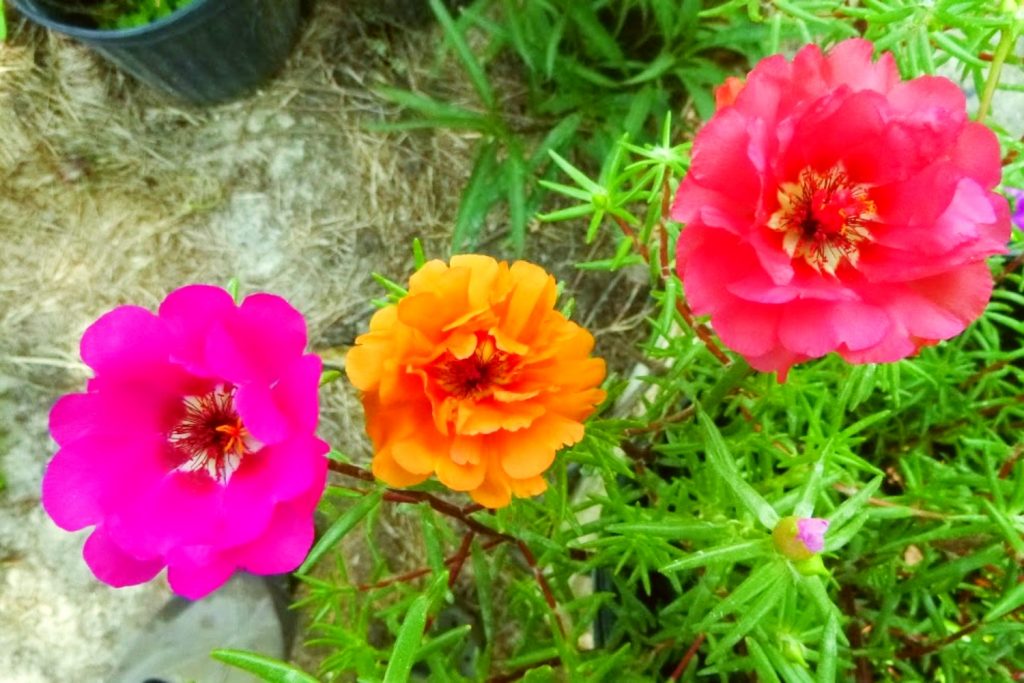
Trailing Lantana
Native to South America, trailing lantana is a tough little plant that grows quickly even in full sun conditions. Trailing lantana is hardy from zones 8 through 11, where it can be kept as a perennial. Plants are drought-tolerant once established and require very little care to grow well, so if you want a beautiful backyard, but you don’t have much time to put into it, trailing lantana may be right for you.
Trailing lantana comes in a wide variety of colors, including white, orange, pink, and purple, which is one of the most commonly seen. Just like shrub varieties, trailing lantana produces clusters of flowers that are very popular with pollinating insects. Plants produce a pleasant sweet yet herbal aroma that gives your garden a fresh fragrance.
Plant your trailing lantana in potting soil that contains 20 to 30 percent sand. These plants grow best in moist soil, but if it doesn’t drain well, the plants won’t produce many flowers. If exposed to boggy soil for prolonged periods, your trailing lantana may die. So avoid overwatering at all costs!
Tips for growing full sun hanging plants
The most important thing when growing full sun hanging plants is to meet the plant’s growing requirements. Obviously, you should make sure the plants get plenty of sunlight. But be sure to meet their soil and water requirements, too, or the plants may not be able to perform as well as they should.
Also, be sure to choose the appropriate plants for your growing zone and fertilize them regularly to encourage healthy foliage and bloom production. The better you care for your sun-loving hanging plants, the easier it will be for them to thrive.

Great ideas for this coming season: Thanks